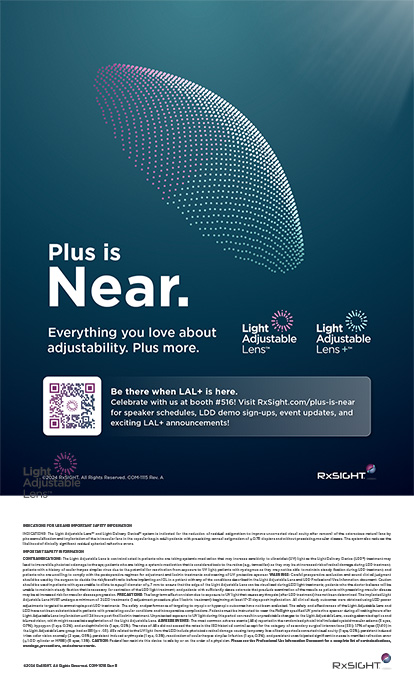With looming cuts to reimbursement and the uncertainty over how health care will be delivered in the future, it is wise for practitioners to think about "line" extensions. Simply put, it makes sense to focus on what you know and what you do well. Target these practice lines and emphasize them.
The booming 1990s ushered in the refractive age. The new millennium highlighted a changing demographic—baby-boomers who desire to look and feel good forever. Ophthalmologists welcomed this opportunity for cosmetic procedures and refractive cataract surgery. Today, a too often overlooked area of patient care is dry eye disease. Rather than ignore affected individuals as annoying, nomadic, and unhappy, recognize the tremendous opportunity they represent in terms of their number.
Currently available therapies help patients with dry eyes feel better again and, in the process, increase their trust in you. This article does not discuss these patients' comorbidities, although many of them have additional pathology needing care. Instead, this piece provides several suggestions on how to create an efficient, profitable dry eye service line in your practice.
EDUCATE YOUR STAFF AND PATIENTS
Get everyone in your practice on the same customer service "page." Create and post a dry eye treatment regimen so that all of the members of your team know the drill. Clearly define everyone's roles and responsibilities—from front desk staff to phone personnel to technicians. When a patient asks, "Can you help me with my dry eyes?" the answer should be a definitive "Absolutely. In fact, we specialize in the treatment of dry eye!"
Spend time and practice resources on training your staff about dry eye disease. Develop phone skills and scripts to answer the questions that patients frequently ask. Make sure your waiting room and examination lanes have current information about dry eye and engage your patients in discussing it. Designate a practice "champion" on dry eye who will coordinate and manage the education of your staff and patients. Make sure that the dry eye component of your practice is listed on your Web site and in your newsletter. Highlight this service when communicating with patients and sources of referrals. The more your patients with dry eyes feel like they are in the right place, the more likely they are to ask you about treatment.
GET THE WORD OUT
Reach out to all of your patients and start promoting your dry eye treatment center. Let all of them know that you specialize in the rehabilitation of dry eye disease. Send recall cards or letters to patients you have not seen in a while. You also may want to conduct dry eye seminars to call the community's attention to your expertise in this area.
RECOGNIZE AN OPPORTUNITY FOR GROWTH
For many practices, treating dry eye disease is a growth opportunity. The overall value of your dry eye patients is probably much greater than you previously thought. For instance, the majority of dry eye patients are women. Approximately 70% of health care decisions are initiated by women, as they are often considered the health care decision makers of the family. Female patients are more likely to refer a family member or friend to their doctor.
Furthermore, The 2005 Gallup Study of Dry Eye Sufferers reported that significant numbers of dry eye patients have experienced the following conditions1:
- 60% seasonal allergies
- 48% myopia
- 17% failing eyesight
- 14% cataracts
- 4% age-related macular degeneration
- 3% glaucoma
Simply put, do not underestimate the impact that this patient group can have on your practice.
You should develop and publish a standard of care to enhance delivery, empower your staff to meet patients' needs, and carefully analyze your delivery of care to ensure you are meeting your standard. Remember that it takes focus, leadership, and exceptional customer service to successfully integrate new offerings into your practice.
EMBRACE THE DRY EYE PATIENT
In the past, eye care specialists often did little more than tolerate this type of patient by doing whatever they could with palliative measures and hoping for the best. Whatever happened happened! Now, it is important to take advantage of new treatment options and welcome these patients into the practice. You can be sure that happy dry eye patients will be singing your praises, labeling you as the eye doctor that finally understood, and put them on the road to feeling better.
James. A Rienzo is a senior eye care business advisor at Allergan, Inc., in Smithtown, New York. Mr. Rienzo may be reached at (631) 875-2713; rienzo_james@allergan.com.


